Toyota Proace Electric Review 2025
Toyota Proace Electric At A Glance
When it comes to moving away from internal combustion, Toyota is keeping its options open. The manufacturer that led the hybrid revolution is now doing the same with hydrogen and its only fully electric models are in its LCV line-up, where the company has a tie-in with Stellantis. The Toyota Proace Electric is its mid-size offering, with the benefit of an unrivalled 10-year warranty, but is it the van to suit your needs? Read our complete Toyota Proace Electric review to find out.
Sharing its basic bodywork and interior layout with the Citroen e-Dispatch, Peugeot e-Boxer, Fiat e-Scudo and Vauxhall Vivaro Electric, the Toyota Proace Electric builds on a successful range of electric middleweight vans offered as a result of its joint venture with the Stellantis Group.
As well as a tech-laden cabin, the Toyota Proace Electric comes with a WLPT range of up to 217 miles (WLTP). It has a 75kWh battery that can be charged using either a standard 7.4kW onboard charger or an optional 11kW charger, while a 5-80% charge takes a handy 45 minutes using a 100kW DC public charger. The motor has three drive modes and a total power output of 136PS, with a top speed of 84mph, although in ‘Normal’ power, the total output is 108PS, and in Eco mode that’s reduced further to 84PS.
There are two trim levels: Active and Icon. The former is more sparse and is aimed at fleets and the latter, plusher model is more suited to private and small business users.
One of its cleverest features is its ‘e-Power Take-off Unit’, which can be used to supply smaller power tools or fridge units for refrigerated vans using power from the main battery, while there’s also an impressive suite of new, advanced safety kit.
The body and cargo volume are the same as the standard diesel Toyota Proace, with the electric motor under the bonnet where the engine would be on a standard model.
All variants come with a 10-inch HD touchscreen with wireless smartphone mirroring, inductive charging, voice recognition and steering wheel-mounted audio controls. There’s a new digital instrument cluster, while paddle shifters allow drivers to choose from four levels of regenerative braking, the latter significantly assisting range in heavy traffic.
Opt for the Icon trim and you’ll get a wide array of safety and driver assist features, such as rear parking sensors, intelligent speed assistance, lane keep assist and driver attention alert, along with Dynamic Surround View, which uses a digital rear view mirror to display imagery from side and rear-view cameras direct to the driver’s eyeline via a rear-view mirror-shaped screen.
While all of the Stellantis vans are much of an admittedly very good muchness, the Toyota’s trump card comes in the form of its 10-year/120,000 miles warranty, which is unrivalled in the LCV market and will invariably enhance its appeal among smaller business and private users.
Driving the Toyota Proace Electric
The Toyota Proace Electric is one of the best mid-size vans to drive, with adaptive variable damping, which make it far more comfortable than most vans over bumps when unladen. The steering is sharp and precise and the handling is impressive for a light commercial vehicle.
Both trim levels are well-equipped and comfy, with three front seats and a hidden storage locker beneath the passenger bench, ideal for concealing power tools and laptops.
The cabin has been extensively facelifted compared with earlier Toyota Proace models with better materials and a new flat-bottomed steering wheel, which gives better space for getting in and out of the cabin and will be appreciated by taller and larger drivers. It’s a spacious and ergonomically considerate van overall.
There are three drive modes, selectable via a switch next to the gear lever. To benefit from the most range you’ll need to drive in ‘Eco’. In ‘Normal’ mode, the battery range will drop by about 10 per cent, but the van is notably more eager. ‘Power’ will reduce that range further but is useful for overtaking and joining fast roads via slip roads, proving you remember to switch it off again – when you consider that it automatically engages with the gearbox kickdown function, it’s arguably not needed at all.
The Toyota Proace Electric is a convincing proposition - one of the most competitive electric vans on the market, made even more appealing thanks to an unrivalled, comprehensive warranty.
Toyota Proace Electric interior
In terms of load space and payload, the Toyota Proace remains one of the most competent load carriers in its class, with gross vehicle weights ranging from 2635kg - 3100kg, depending on spec, meaning an impressive maximum payload of 1450kg.
It is available in two lengths (imaginatively named Short and Long) and even the smaller model will carry two Euro pallets, though the larger version will carry three Euro pallets unless specified in crew van format, where it will still carry two.
All versions get twin side sliding doors as standard, each of which will take a Euro pallet sideways, with keyless electric release on the higher spec variant.
There are other medium vans that will carry more load volume, notably the Volkswagen Transporter and Renault Trafic, but 5.8 cubic metres of usable space will be sufficient for most users and there’s also an optional load-through bulkhead – known by Toyota as the Smart Cargo feature - that increases capacity to 6.6 cubic metres.
There’s just the one roof height on offer in the UK, with its load height being limited to 1397mm. The rear doors open to provide a load width of 1282mm and 1220mm in height.
Crew cab versions will carry six adults, although the passenger in the front middle seat will find legroom cramped due to the location of the gear lever. The rear seats can be folded away with the optional moveable bulkhead.
The cabin itself is well laid-out and comfortable, with a new 10-inch touchscreen controlling most of the functions. It’s intuitive and easy-to-use, our only real gripe being that some of the internal plastics feel a bit harsh and plasticky, notably the inner door panels.
Other changes from 2024-on include inductive charging for mobile phones, plus the option of ‘Dynamic Surround Vision’ which uses a network of cameras to transmit rearward visibility to the driver through a screen where the rear-view mirror would normally be found.


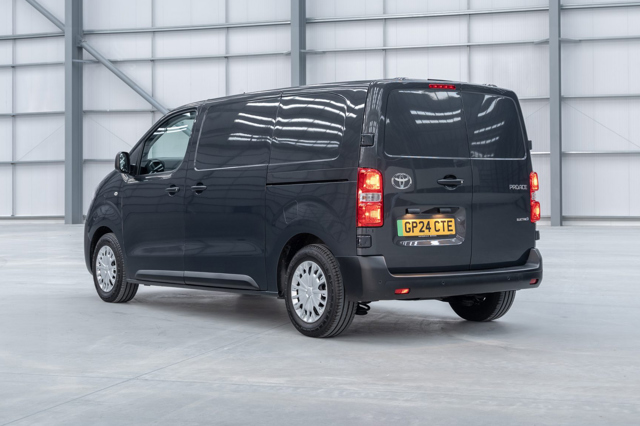
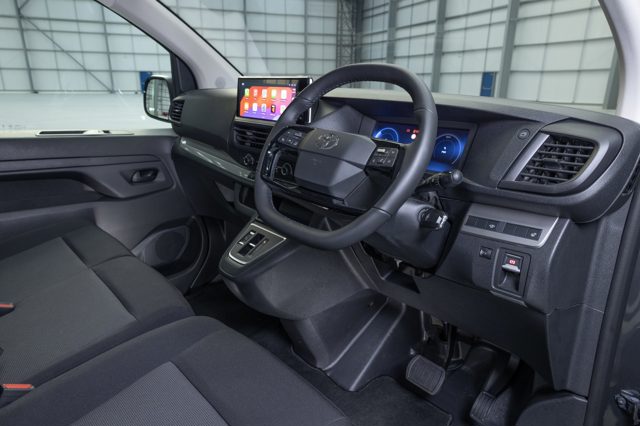
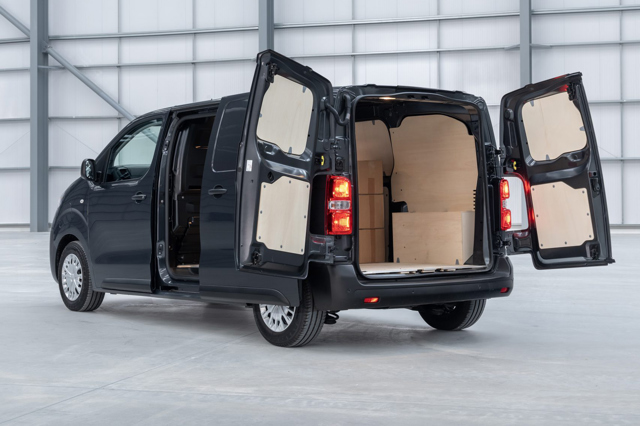
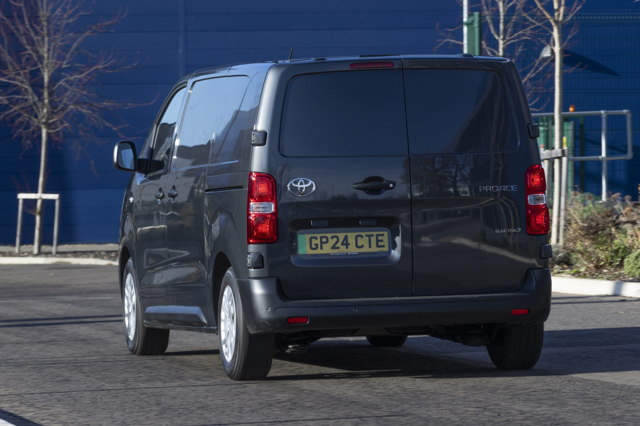
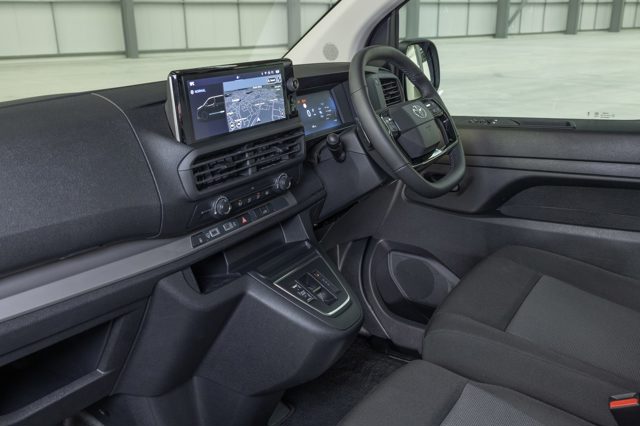
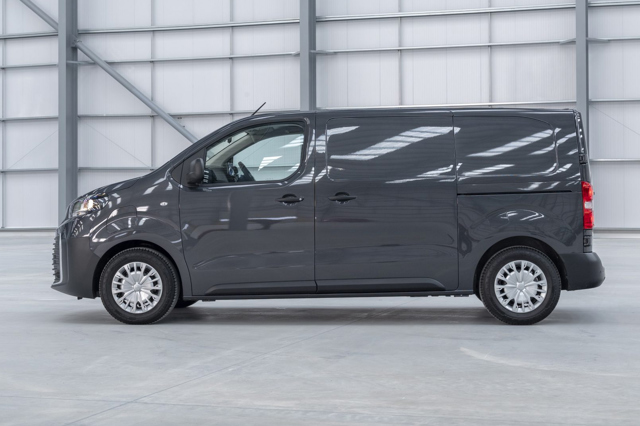
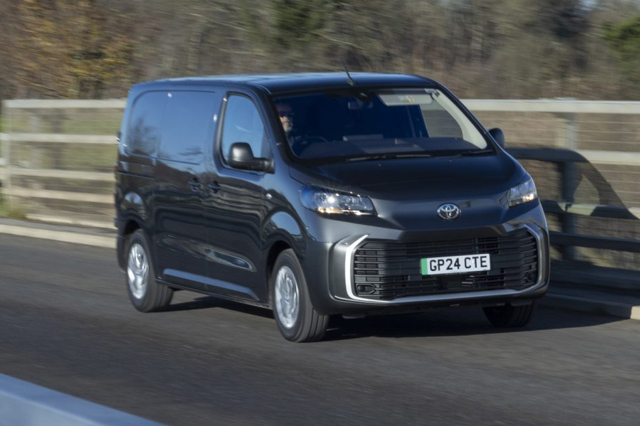
:no_upscale():format(webp)/https://cdn.uk.prod.group-mobility-trader.com/images/cas/b081a1e2972e8ae1f498367dd5f3348b/0435353c21a0ec49955f0df3ed50411b.jpg)

 Good to drive, impressive payload for an electric van, compact dimensions
Good to drive, impressive payload for an electric van, compact dimensions
 Only one roof height, smaller load volume than rivals
Only one roof height, smaller load volume than rivals
:no_upscale():format(webp)/https://cdn.uk.prod.group-mobility-trader.com/images/cas/86891bf1b234c9745c961d575beccbd8/473938797956eaa6949fbd74d6c31854.jpg)
:no_upscale():format(webp)/https://cdn.uk.prod.group-mobility-trader.com/images/cas/dca8d5d87aa7f5643a38e37119a7084b/c7af8785dee501c8faf14561eea35f54.jpg)
:no_upscale():format(webp)/https://cdn.uk.prod.group-mobility-trader.com/images/cas/b081a1e2972e8ae1f498367dd5f3348b/0435353c21a0ec49955f0df3ed50411b.jpg)